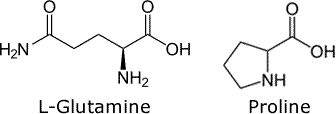August is inevitably a quiet month but September gets off to an early start with the VI International Conference on Managing Quality in Food Chains to be held at Cranfield University on 2 - 5 September. The Group has been helping to promote this event and there are still places available for those wishing to attend.
Another important date in our Annual General Meeting and the presentation of the David Miller Travel Bursary Awards to this year's winners on 20 September. Following the presentations, this year's winners will give talks on the projects they are involved with on bacterial pesticides and iridescent plants. In addition last year's winners will also be giving us an update on their projects. This year the event is being held at the Oxford Botanic Garden as Belgrave Square is undergoing refurbishment and day afternoon will conclude with a tour of the botanic gardens led by Senior Curator, Alison Foster.
Sadly, the planned tour of the Cotswolds, based around Moreton-in-Marsh has had to be cancelled.
Editor
Bowood House, Rhododendrons and Gardens
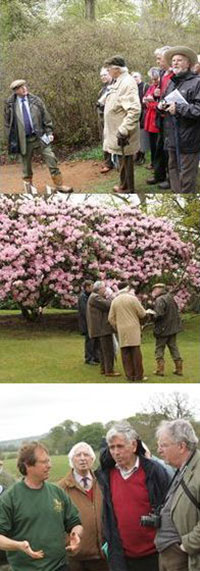
The estate was purchased with the fortune left by Sir William Petty (1623-87). An economist, scientist and philosopher he was Physician General to Cromwell's army in Ireland. Following the demise of the Commonwealth he continued under succeeding kings and became a founder member of the Royal Society. However it was his grandson John Petty, 1st Earl of Shelburne who had the main house (the big house) and its attendant service buildings (the small house) built.
Within this 'small house' was a laboratory, fully equipped to the standard of the time, and it was here on 1 August 1774 that Dr Joseph Priestley discovered oxygen. The laboratory was later used by his friend and fellow scientist Dr Jan Ingenhousz who in 1779 watched the bubbles of gas rising from the undersides of submerged plants when exposed to light and led him to discover the process of photosynthesis.
As so often happens, the fortunes of the estate waxed and waned over the years and it was eventually inherited in 1972 by the present Marquess of Lansdowne. He set about the no mean task of securing the financial future of the estate by opening it to the public and creating a hotel and golf complex within the grounds. Fortunately, the 'big house', potentially a serious financial burden, had fallen into disrepair after the second world war and was demolished in 1955 leaving the more manageable 'little house' that stands today.
One of the main features of the grounds is the Rhododendron collection which has been assembled over the last 160 years. The collection was started in 1854 with 300 plants from the original acquisitions of Joseph Hooker's expeditions. The present Lord Lansdowne has added considerably to the collection with new acquisitions as well as new selections bred in the gardens.
He was eager to show us around this collection, explaining how the local geology had provided an ideal site for the species. Jutting into the south west corner of the estate is a band of lower greensand, a rock whose acidity and porosity seems to provide just the environment Rhododendrons thrive in.
Covering over 60 acres and sheltered under a mature oak woodland the collection consists mainly of evergreen species and cultivars of all sizes and colours. However, where Rhododendrons thrive so usually do Magnolias so there is a secondary collection of this genus interspersed with the Rhododendrons. There are also a number of Cornus species and some Pieris, in particular a local selection Pieris formosa 'Bowood Cascade'.
The main grounds of the house were laid out by Capability Brown in the 1760s which include the usual remodelled landscape with strategic stands of trees around a large artificial lake. The present head gardener, David Glass, described how terraces were added in front of the 'small house' in the 19th century. These are now laid out with box trimmed beds around fastigiate yews. These beds are filled with seasonal bedding and, at the time of our visit, tulips were putting on an excellent display with cultivar 'Queen of the Night' especially prominent.
A long herbaceous border has recently been added under the terrace of the east wing leading to a 4 acre walled garden. Once the main garden supplying fruit, vegetables and flowers to the house it is now largely down to grass and mainly used for the private recreation of the family and to provide cut flowers for the house and hotel. Some fruit trees do however remain and, although the original glasshouses have long disappeared, some smaller modern ones are used for producing ornamentals and the grape vines. Planted inside the glasshouse these are not flourishing due to an excessive infestation of mealy bug and the inevitable shortage of labour.
Elsewhere in the parkland there is also an extensive arboretum which is constantly being added to although sadly we did not have time to visit.
Pictures
Upper: Lord Lansdowne (left) addresses the group
Centre: One of the many fine rhododendrons
Lower: Head Gardener, David Glass, (left) describes the formal gardens
Peter Grimbly
Plant of the Month
Cyclamen hederifolium, sowbread, Primulaceae (APG III), Myrsinaceae (APG II)
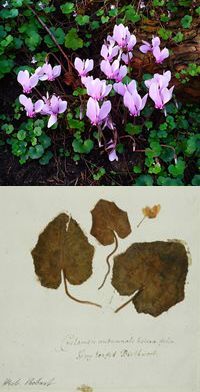
The plant now known as Cyclamen hederifolium is first recorded in the Oxford Botanic Garden in 1648 as 'Cyclamen folio oblongo' (long-leaved sowbread). Ten years later it was being called 'Cyclamen autumnale folio angusto', and 'Cyclamen autumnale longifolium' had also emerged as another name for the species. All of these names were combined for one dried specimen, labelled as 'Cyclamen autumnale folio longo angusto'. That specimen was later given the much simpler name Cyclamen neapolitanum, which has since been recognised as a synonym for the species Cyclamen hederifolium.
The differences in these names are mainly due to botanists relying too heavily on the plant's leaves to make their identification. While the leaves of long-leaved and ivy-leaved cyclamen specimens do have different shapes, other features of the plants are so similar that it makes most sense to classify them as one species. Cyclamen species have the common name sowbread for the simple reason that their loaf-shaped roots are said to be eaten by pigs.
The species was thought to be useful by various 17th century authors, though they did not always agree on what the plant actually did.
The herbalist John Gerard recommended Cyclamen hederifolium for all manner of complaints. He wrote of powdered roots curing jaundice and 'stoppings of the liver', with that same treatment, when drunk with wine, being 'very profitable against all poison, and the bitings of venomous beasts'. He even went so far as to say that the leaves, stamped in honey and applied to the eyes, cured 'all impediments of the sight'.
Gerard also wrote of the plant's use for less serious complaints, such as clearing 'tough and grosse flegme' and removing 'Sun-burning, and all blemishes of the face'. It does not only appear to have been used facially, either: '[the juice] doth open the Hemorrhoids, and causeth them to flow'.
Cyclamen hederifolium was used for aborting pregnancies threatening the mother's health, according to Gerard and his contemporary John Parkinson. Indeed, Gerard seemed to believe the plant was so powerful that any pregnant woman so much as walking over them 'shall be delivered before their time'. So concerned was he about this that he fenced them off in his garden 'lest any woman should by lamentable experiment finde my words to bee true'. It is safe to say that a later (and better-informed) editor - Thomas Johnson - disagreed: 'I judge our Author something too womanish in this... [his claim is] vaine and frivolous.'
One of Gerard's other suggestions was that small cakes made from the plant were 'a good amorous medicine to make one in love'. Sadly, this idea was put down too - by Parkinson this time - who believed the claim was 'meere fabulous.' Gerard also wrote that 'given in wine... it maketh a man drunke,' although the cyclamen's contribution to this effect is debatable.
Alison Foster
Oxford Botanic
Garden
Medicinal Plant of the Month
Zea mays, sweetcorn, maize, Poaceae
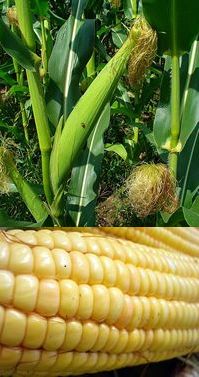
When we take medications, in whatever form, how many of us realise that the active component is often only a small proportion of the formulation? The bulk of the medication (suppository, transdermal patch, solution, inhalation powder, tablet etc) that is not the active pharmaceutical ingredient has many different functions. Excipients facilitate the packaging of active ingredients. They can be used to enhance the absorption of the drug into the body, to alter the rate of absorption (i.e. to generate a slow release formulation) and to mask unpleasant tasting drugs.
Coatings are used to protect the contents from atmospheric moisture or to mask the bitter taste of the interior. Most tablets are coated with hydroxypropylmethylcellulose (HPMC), which is sugar free and does not contain potential allergens. Sometimes other coatings are used. One such is zein, a prolamine protein isolated from maize. Prolamine proteins are a group of plant storage proteins that have a high proline and glutamine content.
Maize is also an excellent source of starch - another commonly used excipient in tablets.
Alison Foster
Oxford Botanic
Garden
Horticulture Industry News
For the very latest horticultural news follow us on Facebook,
Twitter, or LinkedIn
World changing technology enables crops to take nitrogen from the
air
Nitrogen fixation is vital for plants to survive and grow. However, only a
very small number of plants, most notably legumes have the ability to fix
nitrogen from the atmosphere with the help of nitrogen fixing bacteria. The
vast majority of plants have to obtain nitrogen from the soil, and for most
crops currently being grown across the world, this also means a reliance on
synthetic nitrogen fertiliser.
Now a unique method of putting nitrogen-fixing bacteria into the cells of plant roots has been developed. This major breakthrough came when researchers found a specific strain of nitrogen-fixing bacteria in sugar-cane which could intracellularly colonise all major crop plants. This ground-breaking development potentially provides every cell in the plant with the ability to fix atmospheric nitrogen. The implications for agriculture are enormous as this new technology can provide much of the plant's nitrogen needs. More
Broccoli may slow arthritis
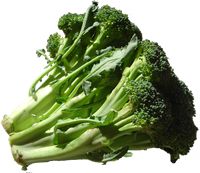
A new treatment for heart disease
New research has identified molecules occurring naturally in fruit that may
play an important role in the future treatment of heart disease. Molecules
called flavanoids, which are found in citrus fruits, particularly grapefruit,
have proven effective at reducing the inflammation which can lead to deadly
cardiovascular disease. These molecules may hold the key to the development
of a new generation of anti-inflammatory drugs which are cheaper, easier to
produce and less toxic than current therapies.
Many diseases of the circulatory system are linked to the improper activation of immune cells, which then stick to the so called vascular endothelial cells (VECs) that line the blood vessels. This can begin a process of excessive inflammation through the local production of immune molecules, blocking the blood vessels and causing deadly cardiovascular disease. Derivatives of the flavanoid, naringenin, has been shown to effectively inhibit the inflammatory processes triggered following activation of the receptor for immune molecule IL6 on the surface of VECs. More
Climate change threatens crunchy, tart apples …
Rising temperatures can make apple trees flower earlier. Researchers decided
to look at how this shift affects the quality of the fruit. The team analysed
four decades' worth of data collected from two varieties of apple. They found
that the hardness and acidity of the apples had declined during that time,
while their sweetness had increased. The changes may not be apparent to consumers
because they took place so gradually. However, if you could eat an average
apple harvested 30 years before and an average apple harvested recently at
the same time, you would really taste the difference. More
….while weather ruins nutmeg crop….
Indian nutmeg farmers are in severe crisis due to a massive Phytophthora attack drastically ruining their crop. Experts and farmer organisations estimate
that there will be at least 35 per cent dip in the total yield this time as
compared to the last. Since marginal and small farmers constitute the majority
of nutmeg farming community for whom it is the single source of income, the
crop loss can generate intense economic and social crisis. The impact of the
attack can adversely affect the farmers and economy for the next three to
four years. The rise in humidity because of unprecedented rain is the main
factor behind the spread of the fungus. It firstly creates water-soaked lesions
in the leaves. These then spread to other parts of the tree. More
… and causes Avocados to shrink…..
Avocado fruits usually weigh half a pound or more. In the summer of 2013,
though, hundreds of thousands of trees in Southern California are sagging
with the tiniest Hass avocados in local memory - some just the size
of a golf ball. The main reason for the lemon-sized fruits, sources say, is
a very unusual growing year that consisted of low winter rainfall in early
2012 (avocados spend more than a full year developing on the tree), erratic
bee activity during the late spring bloom period, and lots of unseasonably
cool and cloudy weather in the year since. More
… but was perfect for a bumper apple harvest
This year's weather has created the ideal conditions for a bumper crop of
sweet and rosy apples, experts say. Last year's wet autumn followed by the
icy spring and a hot summer were perfect for apple growing. Last year's apple
orchards experienced a poor harvest after a cool and wet spring and summer.
Apples evolved in central Asia to suit a continental climate of hot summers
and very cold winters and need to be exposed to a certain amount of cold weather
each winter or they won't flower or fruit properly.
The wet autumn in 2012 helped to rule out the chance of drought, which can lead to small, poor-tasting fruit. Chilly conditions right up until April gave the trees enough 'chill time' for the fruit to set properly and held back flowering. By the time they did flower, there were more insects around to pollinate the blossom and less risk of damage by frost. Then very hot weather in summer boosted ripening. More
India begins commercial production of olive oil
Commercial production of olive oil is due to begin in September 2013 in Rajasthan
as part of a state government-funded project that has supported the planting
of more than 144,000 olive trees on 260 hectares since 2008. With long, dry
summers and short, cool winters, conditions in the Indian state are ideal
for producing olives. The aim is to press 25 tonnes of olive oil in 2013 and
over the next three years plant another 5,000 hectares. In addition to the
plan to become a leading international producer, Rajasthan hopes to begin
tapping into rising demand for olive oil in India.
Science promises strawberry fields forever
British field-grown strawberry growers have a new hi-tech weapon in their
armoury. The biggest growers are using a state-of-the-art forecasting system
that allows them to predict the yields in individual fields. The specialist
technology compares historical yield curves, the recorded effect weather has
on the crop and the planting date of the strawberries in their respective
locations. The information is then fed into a computer along with long-term
weather forecasts, specific growing data for some of the 600 varieties of
strawberry produced in the UK, and growth charts for each field.
The new system is helping the UK's biggest growers, who are responsible for producing around 20,000 tonnes of strawberries - a third of the annual UK crop. It involves field visits up to three times a week, when light levels and plant growth are recorded. The collated information has helped growers accurately determine when to plant their crops to ensure yields mature throughout the season, 'smoothing out' the supply of strawberries to the supermarkets. More
Science spin-out adds colour to forest measurements
New laser technology is being used to measure and map forest carbon in more
detail than ever before. Described as an 'MRI scanner for forests' its creators
are now taking the technology to market with the launch of a new business
called Carbomap. Laser scanners are used to produce detailed three-dimensional
maps of forest materials. However, until now, the scanners have operated at
a single wavelength, effectively mapping forests in black and white.
Carbomap's sophisticated scanners will measure forests at four different wavelengths, adding colour to the picture, letting analysts distinguish between different forest materials. The unique data can be used to give more accurate estimates of the amount of carbon stored in a forest, and so give a stronger indication of forest health. The lasers can also be attached to aircraft, allowing them to cover large areas in short periods of time, and map remote areas that might be inaccessible on the ground.
Brachypodium is NOT Arabidopsis
Arabidopsis is a model organism, but for what exactly? Many would
like us to believe that it is a model for all plants. However, with those
organisms newly defined as 'photosynthetic eukaryotic organisms, including
algae and possibly cyanobacteria', that is a truly tall order for such
a slight specimen! However, and at the other end of that spectrum of opinion,
there are those who espouse the view that Arabidopsis is truly only
a model for, well, other arabidopses. Adding to the debate it is revealed
that interactions between the plant hormones ethylene and auxin in roots of
the monocot Brachypodium distachyon ('another' model
plant) differ to those in roots of the dicot Arabidopsis.
Whereas lowered levels of auxin in Arabidopsis, which can be caused by increases in another hormone - ethylene - result in shorter roots, in Brachypodium increases in ethylene lead to elevated levels of auxin and longer roots. The latter's 'inverted regulatory relation between the two hormones' points to 'a complex homeostatic crosstalk between auxin and ethylene in Brachypodium roots, which is fundamentally different from Arabidopsis and might be conserved in other monocotyledons'. More
Britain's first protected hops
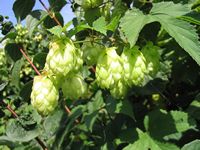
Defra is encouraging producers to apply for protected status for their products in order to take advantage of the wider markets in the UK and abroad arising from consumers' increasing awareness of where their food and drink comes from. The Protected Food Names scheme provides farmers and producers with a way in which to add value to their product, while helping consumers to identify foods with a clear regional provenance.
Genetically modified crops pass benefits to weeds
Few studies have tested whether transgenes such as those that confer glyphosate
resistance can - once they get into weedy or wild relatives through
cross-pollination - make those plants more competitive in survival and
reproduction. The traditional expectation is that any sort of transgene will
confer disadvantage in the wild in the absence of selection pressure, because
the extra machinery would reduce the fitness.
But now a study challenges that view: it shows that a weedy form of the common rice crop, Oryza sativa, gets a significant fitness boost from glyphosate resistance, even when glyphosate is not applied. In this study the researchers found that the transgenic hybrids had higher rates of photosynthesis, grew more shoots and flowers and produced 48-125% more seeds per plant than non-transgenic hybrids - in the absence of glyphosate. More
Plant-based inhibitor could halt HIV infection
A compound derived from soybeans and other plants may have HIV-fighting properties,
according to new research. The study found that the plant-based compound genistein
stopped HIV infection in resting CD4 T cells - specialised cells in the immune
system. Genistein is a tyrosine kinase inhibitor that works by blocking the
communication from a cell's surface sensors to its interior. HIV gets into
the interior of cells and spreads infection by tricking some of the sensors
on the surface of cells to trick them into sending the signals to the interior.
Instead of acting directly on the virus, genistein blocks this signalling process
that allows the virus to infect cells. In this way, genistein makes it more
difficult for the virus to become resistant to drugs.
Genome duplication aids plant's survival in saline soils
Having more than two sets of chromosomes can increase a plant's ability to
take up nutrients and survive in saline soils. Researchers found that polyploidy,
the condition of having more than two genome copies, causes the flowering
plant Arabidopsis thaliana to accumulate a greater amount of potassium
in its leaves and demonstrate a higher tolerance to saline environments. Most
flowering plants are diploid, having two copies of a genome. More
Weeds warrant urgent conservation
Faced with climate change, plant breeders are increasingly turning to the
genomes of the wild, weedy relatives of crops for traits such as drought tolerance
and disease resistance. But a global analysis of 455 crop wild relatives has
found that 54% are under-represented in gene bank collections - and that
many, including ones at risk of extinction, have never been collected. The
findings will guide the largest international initiative so far to conserve
crop wild relatives. The effort - which is being spearheaded by the
Global Crop Diversity Trust, based in Bonn, Germany, in partnership with the
Millennium Seed Bank at the Royal Botanic Gardens in Kew, UK - is deemed
urgent at a time when one in five plants faces extinction. More
Secret of plant geometry revealed
While the control of branch number and positioning around the main root and
shoot are now well understood, scientists have long puzzled over how plants
set and maintain the angle of their lateral branches relative to gravity.
How, for instance, does a young Lombardy poplar sends its branches up close
to the vertical, while an oak sapling's spread is much flatter. The
puzzle is complicated by the fact that the angle of root and shoot branches
is not usually set relative to the main root or stem but relative to gravity.
Scientists did not understand how plants were able to set, relative to gravity,
the particular non-vertical angle of growth for their branches - known
as their 'gravitropic set-point angle'.
Now researchers have found that another growth component - the 'anti-gravitropic offset' that counteracts the normal gravitropic growth in these lateral branches. This offset mechanism sustains growth on the other side of a branch from the gravity-sensitive growth and prevents the branch from being moved beyond a set angle to the vertical. It turns out that this countervailing growth is also driven by auxin, the same hormone that causes gravity responsive growth on the lower side of the branch. Branches that are growing close to the vertical have a weak anti-gravitropic offset, while in branches that are growing out at shallow angles away from the vertical the anti-gravitropic offset is relatively strong.
Events Calendar
Managing
Quality in Chains
2 - 5 Sep, International Society for Horticultural Science
Cranfield, UK
Tropical
Horticulture
2 - 6 Sep, International Society for Horticultural Science
Santiago de Querátaro, Mexico
Image
Analysis Methods in the Plant Sciences
2 - 3 Sep, Nottingham University
Nottingham, UK
Fungal
diseases, diagnostics and drug discovery
2 - 4 Sep, Society for General Microbiology (SGM) and
British Society for Medical Mycology
Brighton, UK
Four Oaks Trade Show
3 - 4 Sep
Lower Withington, UK
Plum Pox Virus
3 - 6 Sep, International Society for Horticultural Science
Olomouc, Czech Republic
Agchem
Forum
4 - 5 Sep, British Crop Production Council
Barcelona, Spain
International
Strawberry Congress
4 - 6 Sep, Hoogstraten
Antwerp, Belgium
Green
viruses, from gene to landscape
7 - 11 Sep, EMBO
Hyères-les-Palmiers, France
Managing
the Urban Forest
8 - 11 Sep, Arboriculture Association
Exeter, UK
Ornamentals
in Africa
9 - 13 Sep, International Society for Horticultural Science
Naivasha, Kenya
Potato Europe
11 - 12 Sep, DLG
Emmeloord, The Netherlands
Regulation
of Fertilization and Early Seed Development
11 - 13 Sep, Biochemical Society
Bath, UK
Landscape and Urban Horticulture
12 - 14 Sep, International Society for Horticultural Science
Kolkata, India
Open
Afternoon at Warwick Crop Centre
18 Sep, Warwick Crop Centre
Warwick, UK
Pomegranate and
Minor Mediterranean Fruits
20 - 24 Sep, International Society for Horticultural Science
Taian, China
AgriGenomics
24 - 25 Sep, Select Biosciences
Norwich, UK
Knowing
your enemy - the future of crop protection
5 Sep, HGCA
London, UK
International
Advances in Plant Virology
25 - 27 Sep, Association of Applied Biologists
Norwich, UK
Sustainable
intensification: The pathway to low carbon farming?
25 - 27 Sep
Edinburgh, UK
BCPC Congress
1 - 2 Oct, British Crop Production Council
Brighton, UK
South West Growers
Show
2 Oct
Exeter, UK
New Technologies
for Environment Control, Energy-saving and Crop Production in Greenhouse
and Plant Factory
6 - 11 Oct, International Society for Horticultural Science
Jeju, Republic of Korea
Crop
Breeding over 10,000 years; Lessons for current and future challenges
7 - 8 Oct, Association of Applied Biologists
Cambridge, UK
European
Congress on Chestnut
9 - 12 Oct, International Society for Horticultural Science
Debrecen, Hungary
Medicinal
Plants and Natural Products
14 - 16 Oct, International Society for Horticultural Science
Lima, Peru
IPM:
Pushing Back the Frontiers
15 - 16 Oct, Association of Applied Biologists
Marston, UK
Asparagus
Symposium
17 - 19 Oct, International Society for Horticultural Science
Nanchang, China
Organic
Matter Management and Compost Use in Horticulture
20 - 25 Oct, International Society for Horticultural Science
Santiago, Chile
Eighth National Congress
of Applied Entomology
21 - 25 Oct, University of Barcelona
Barcelona, Spain
Cactus Pear
and Cochineal
28 - 30 Oct, International Society for Horticultural Science
Palermo, Italy
Organic
Greenhouse Horticulture
28 - 31 Oct, International Society for Horticultural Science
Avignon, France
Crop World Global
29 - 30 Oct, UBM
Amsterdam, The Netherlands
Fruit Culture and its
Traditional Knowledge along Silk Road Countries
4 - 8 Nov, International Society for Horticultural Science
Tbilisi, Georgia
Fruits
and Roots: A Celebration and Forward Look
6 - 7 Nov, Association of Applied Biologists
East Malling, UK
Plant Breeding Congress
10 - 14 Nov
Antalya, Turkey
GroSouth
13 Nov, Roundstone Nurseries
Chichester, UK
BCPC
Weed Review
14 Nov, British Crop Production Council
Rothamsted, UK
Pests
and Natural Enemies in Fruit Crops
14 Nov, Royal Entomological Society and East Malling Research
East Malling, UK
Bacterial Canker of
Kiwifruit
19 - 22 Nov, International Society for Horticultural Science
Mt Maunganui, New Zealand
Onion
& Carrot Conference & Exhibition
20 - 21 Nov
Peterborough, UK
Farm Business
Innovation
28 - 29 Nov, Prysm Media
London, UK
If you would like to advertise a forthcoming event please contact ester.monfort@soci.org
Horticulture Group Contact Details
For submitting ideas or to volunteer to be part of a committee or a group, please contact:
Chairman - Peter Grimbly
Meetings Secretary - Alison Foster
Minutes Secretary - Margaret Waddy
Newsletter co-ordinator - Sue Grimbly scihortigroup@btinternet.com
Group Contact - Ester Monfort Martinez, E: ester.monfort@soci.org T: +44(0)20 7598 1584

